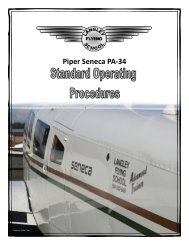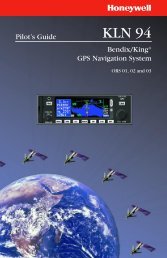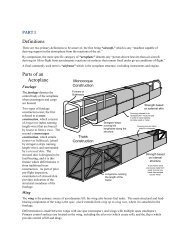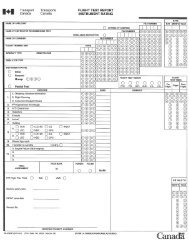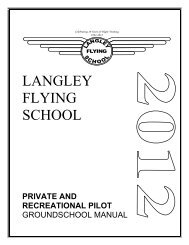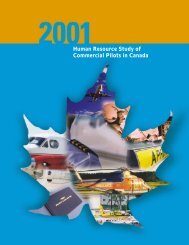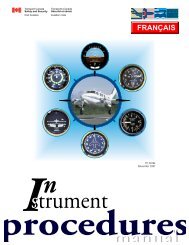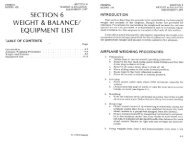LANGLEY FLYING SCHOOL Flight Training Handbook
LANGLEY FLYING SCHOOL Flight Training Handbook
LANGLEY FLYING SCHOOL Flight Training Handbook
Create successful ePaper yourself
Turn your PDF publications into a flip-book with our unique Google optimized e-Paper software.
<strong>Flight</strong> <strong>Training</strong> <strong>Handbook</strong> Page 42<br />
Langley Flying School, Inc.<br />
inadvertently selecting a seven in the first two digits of the display—Code 7700 is for emergencies, and 7600 is for a<br />
communications failure. 40<br />
After you have finished your pre-takeoff checks, taxi your aircraft to the hold position and switch your radio to the<br />
Tower Controller’s frequency. Then check for any aircraft that might be on final approach for landing—if an<br />
aircraft appears on final approach, it is clear that you will not be given a clearance for takeoff and you might as well<br />
wait with your request until the aircraft has landed. If the approach appears clear, make your request for a takeoff<br />
clearance:<br />
Takeoff Clearance<br />
Pilot:<br />
“Langley Tower, ABC is ready for<br />
takeoff, request back-track.”<br />
Controller: “ABC, back-track approved. Cleared takeoff Runway 19.”<br />
Pilot:<br />
“Cleared takeoff Runway 19, ABC.”<br />
Notice that the “Golf” in GABC identifier is dropped—the controllers already have a record of your full<br />
identification following your first contact with the ground controller. Also, the request for a “back-track” is always<br />
made for Runway 19 departures at Langley Airport—this enables use to taxi back (reverse) along this runway to use<br />
the extra 100’ that is available. The back-track must be requested. Departures for Runway 01 do not require backtrack<br />
requests as the reverse manoeuvre is not required. Note, finally, that the takeoff clearance is always repeated<br />
back (or “read back” to the controller—this is a Langley Flying School rule intended to reduce the probability of<br />
students inadvertently taking off without a clearance—this could be a dangerous mistake as it is common for the<br />
controller to hold an aeroplane in position on the runway while helicopter traffic is cleared to cross over the runway.<br />
Here is an example of this “wait” clearance:<br />
Takeoff Clearance—Wait in Position<br />
Pilot:<br />
Controller:<br />
Pilot:<br />
“Langley Tower, ABC is ready for takeoff.”<br />
“ABC, taxi to position Runway 01 and wait. Helicopter traffic to cross the<br />
runway.”<br />
“To position and wait Runway 01, ABC.”<br />
Arrival<br />
Controller: “ABC, cleared takeoff Runway 01.”<br />
Pilot:<br />
“Cleared takeoff Runway 01, ABC.”<br />
On your first transmission inbound to the airport, simply say your aircraft type and aircraft registration. Once the<br />
controller acknowledges you, provide the controller with your position (remember to include your altitude) and be<br />
sure to provide an accurate description of your location and your intentions. Do not go into great detail (e.g. “I’m<br />
two and a half miles east of Ft. Langley near the ferry docks, indicating 22.7 DME on the 074 Radial on the<br />
Vancouver VOR”). 41 If the controller wants clarification, you will be asked. Here is an example:<br />
Pilot: “Langley Tower, this is Piper Cherokee GABC.” 42<br />
40 ATC radar displays, and the associated software, are designed to set off an aural alarm whenever a “7” has been selected by the pilot<br />
(purposefully or accidentally) as the first digit of a transponder code. When this occurs, the controllers have to hit a reset button, and of course it<br />
can apparently become an irritation to them. There is lots of information in From the Ground Up regarding transponder operations and<br />
procedures (check the index at the back of this book).<br />
41 Keep in mind, however, that there is nothing worse than inaccurate position reported—it is unnecessarily hazardous. If you are two miles south<br />
of 232 nd interchange, report your position as such—don’t advise the controller “Over 232 nd .”<br />
42 We have simply written “GABC” in the above, but of course this should be voiced as “Golf Alpha Bravo Charlie” to make use of the phonetic<br />
alphabet. Notice too that the first letter—in this case “G” is dropped after the first exchange. Also note that the acknowledgement of a<br />
transmission by the pilot simply requires the repeating of the aircraft’s identifier.<br />
2012 David L. Parry



